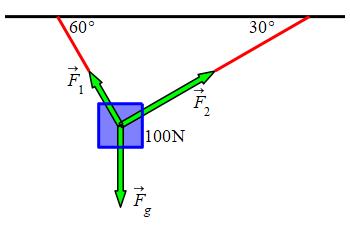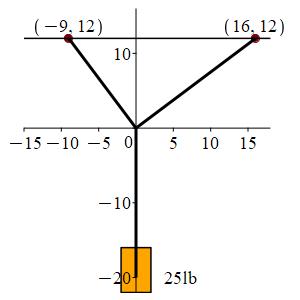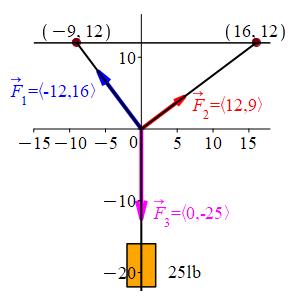5. Vectors
b. Vector Addition
A simple application of vectors occurs in physics when we balance forces to analyze a static situation in mechanics.
4. Application - Balancing Forces
A force is the vector describing how we push on an object: How hard we push is the magnitude and where we push is the direction. Newton's Second Law says if one or more unbalanced forces act on an object, then the object will move with an acceleration \(\vec a\) satisfying \[ m\vec a=\vec F \] where \(m\) is the mass of the object and \(\vec F\) is the sum of all forces acting on the object. If the object is static (not moving) then its acceleration is \(\vec a=\vec 0\) and the sum of the forces must be zero. We can use this to find one or more forces when we know the other forces in a static situation.
In doing these applications, you frequently need to know that the force of gravity on an object (on the surface of the earth) is \(\vec F_g=m\vec g\) where \(m\) is again the mass of the object and \(\vec g=(0,-g)\) is the acceleration of gravity, pulling straight down, whose magnitude is approximately \[\begin{aligned} g&=9.8\dfrac{\text{m}}{\text{sec}^2}&&\text{in mks units} \\ &=980\dfrac{\text{cm}}{\text{sec}^2}&&\text{in cgs units} \\ &=32\dfrac{\text{ft}}{\text{sec}^2}&&\text{in British units} \end{aligned}\] Frequently, in order to avoid dealing with \(g\), we will give the weight of an object instead of its mass. The weight is the force of gravity \(\vec F_g=m\vec g\). The weight is measured in Newtons (in mks units), in dynes (in cgs units) or in pounds (in British units).
An object which weighs \(mg=100\,\text{N}\) is suspended from \(2\) wires which form the sides of a \(30^\circ-60^\circ-90^\circ\) right triangle whose hypotenuse is horizontal at the ceiling. Find the tension (magnitude of the force) in each wire.

Let \(F_1\) and \(F_2\) be the magnitudes of the forces \(\vec F_1\) and \(\vec F_2\). Then the \(3\) forces are \[\begin{aligned} \vec F_1&=\left\langle-F_1\cos60^\circ,F_1\sin60^\circ\right\rangle \\ \vec F_2&=\left\langle F_2\cos30^\circ,F_2\sin30^\circ\right\rangle \\ \vec F_g&=\left\langle0,-mg\right\rangle \end{aligned}\] Newton's Law for a static situation says \(\vec F_1+\vec F_2+\vec F_g=0\). The \(x\)- and \(y\)-components of this equation are \[\begin{aligned} -F_1\cos60^\circ+F_2\cos30^\circ&=0 \\ F_1\sin60^\circ+F_2\sin30^\circ-mg&=0 \end{aligned}\] or \[\begin{aligned} -\dfrac{1}{2}F_1+\dfrac{\sqrt{3}}{2}F_2&=0 \\ \dfrac{\sqrt{3}}{2}F_1+\dfrac{1}{2}F_2-mg&=0 \end{aligned}\] The first of these says \(F_1=\sqrt{3}F_2\). Then the second says \(\dfrac{3}{2}F_2+\dfrac{1}{2}F_2-mg=0\). So: \[\begin{aligned} F_2&=\dfrac{1}{2}mg=\dfrac{1}{2}100\,\text{N}=50\,\text{N} \\ F_1&=\sqrt{3}F_2=50\sqrt{3}\,\text{N}\approx86.6\,\text{N} \end{aligned}\]
Three tugboats are pulling on an ocean liner. The first two exert the forces: \[ \vec F_1=\left\langle3,4\right\rangle \quad \text{and} \quad \vec F_2=\left\langle-4,1\right\rangle \] What is the force \(\vec F_3\) that the third tugboat must exert to keep the ocean liner stationary?
The sum of the forces must be \(\vec 0\).
\( \vec F_3=\left\langle1,-5\right\rangle \)
The sum of the forces must be \(\vec 0\). \[ \vec F_1+\vec F_2+\vec F_3=\vec 0 \qquad (0) \] So \[\begin{aligned} \vec F_3&=-\vec F_1-\vec F_2 \\ &=-\left\langle3,4\right\rangle-\left\langle-4,1\right\rangle \\ &=\left\langle1,-5\right\rangle \end{aligned}\]

A \(25\,\text{lb}\) painting is suspended from a wire which is tied to \(2\) other wires at the origin, as shown in the figure. The painting is at the bottom of the vertical wire. The other \(2\) wires are attached to nails in the ceiling at \((-9,12)\) and \((16,12)\). Find the forces in the upper \(2\) wires.

The forces \(\vec F_1\) and \(\vec F_2\) point in the same directions as the wires \(\vec u_1=\langle-9,12\rangle\) and \(\vec u_2=\langle16,12\rangle\). Write out the equations which say the sum of the forces is \(\vec 0\).
\(\begin{aligned} \vec F_1&=\left\langle-12,16\right\rangle \\ \vec F_2&=\left\langle12,9\right\rangle \end{aligned}\)
For the sculpture to be stationary, the forces must balance and cancel each other out. In other words, the sum of the forces must add to be zero. We express this mathematically as \[ \vec F_1+\vec F_2+\vec F_3=\vec 0 \qquad (*) \] The force of gravity is \(\vec F_3=\langle0,-25\rangle\). The vectors \(\vec F_1\) and \(\vec F_2\) point along the vectors from the origin to the two nails which are \(\vec u_1=\langle-9,12\rangle\) and \(\vec u_2=\langle16,12\rangle\), but we need to change their magnitudes. To do this, we first compute their lengths: \[ |\vec u_1|=\sqrt{9^2+12^2}=15 \quad \text{and} \quad |\vec u_2|=\sqrt{16^2+12^2}=20 \] Then the directions are the unit vectors: \[ \vec u_1=\left\langle\dfrac{-9}{15},\dfrac{12}{15}\right\rangle =\left\langle\dfrac{-3}{5},\dfrac{4}{5}\right\rangle \quad \text{and} \quad \vec u_2=\left\langle\dfrac{16}{20},\dfrac{12}{20}\right\rangle =\left\langle\dfrac{4}{5},\dfrac{3}{5}\right\rangle \] These have length \(1\), but we want them to have lengths \(|\vec F_1|\) and \(|\vec F_2|\). So we multiply the unit vectors by \(|\vec F_1|\) and \(|\vec F_2|\): \[ \vec F_1=\left\langle-\,\dfrac{3}{5}|\vec F_1|,\dfrac{4}{5}|\vec F_1|\right\rangle \quad \text{and} \quad \vec F_2=\left\langle\dfrac{4}{5}|\vec F_2|,\dfrac{3}{5}|\vec F_2|\right\rangle \] We now balance the forces by writing out the components of equation (*): \[\begin{aligned} -\,\dfrac{3}{5}|\vec F_1|+\dfrac{4}{5}|\vec F_2|+0&=0 \qquad (1)\\ \dfrac{4}{5}|F_1|+\dfrac{3}{5}|\vec F_2|-25&=0 \qquad (2) \\ \end{aligned}\]
Equation (1) says \(|\vec F_2|=\dfrac{3}{4}|\vec F_1|\). Then equation (2) says \(\dfrac{4}{5}|\vec F_1|+\dfrac{3}{5}\cdot\dfrac{3}{4}|\vec F_1|=25\). Consequently: \[ |\vec F_1|=20 \quad \text{and} \quad |\vec F_2|=15 \] So the forces are: \[ \vec F_1=\left\langle-12,16\right\rangle \quad \text{and} \quad \vec F_2=\left\langle12,9\right\rangle \]

Heading
Placeholder text: Lorem ipsum Lorem ipsum Lorem ipsum Lorem ipsum Lorem ipsum Lorem ipsum Lorem ipsum Lorem ipsum Lorem ipsum Lorem ipsum Lorem ipsum Lorem ipsum Lorem ipsum Lorem ipsum Lorem ipsum Lorem ipsum Lorem ipsum Lorem ipsum Lorem ipsum Lorem ipsum Lorem ipsum Lorem ipsum Lorem ipsum Lorem ipsum Lorem ipsum